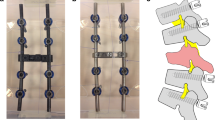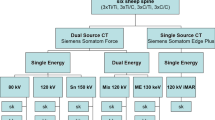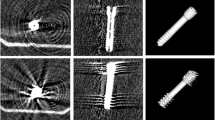Abstract
The aim of this study was to develop a signal-inducing bone cement for magnetic resonance imaging (MRI)–guided cementoplasty of the spine. This MRI cement would allow precise and controlled injection of cement into pathologic lesions of the bone. We mixed conventional polymethylmethacrylate bone cement (PMMA; 5 ml methylmethacrylate and 12 g polymethylmethacrylate) with hydroxyapatite (HA) bone substitute (2–4 ml) and a gadolinium-based contrast agent (CA; 0–60 μl). The contrast-to-noise ratio (CNR) of different CA doses was measured in an open 1.0-Tesla scanner for fast T1W Turbo-Spin-Echo (TSE) and T1W TSE pulse sequences to determine the highest signal. We simulated MRI-guided cementoplasty in cadaveric spines. Compressive strength of the cements was tested. The highest CNR was (1) 87.3 (SD 2.9) in fast T1W TSE for cements with 4 μl CA/ml HA (4 ml) and (2) 60.8 (SD 2.4) in T1W TSE for cements with 1 μl CA/ml HA (4 ml). MRI-guided cementoplasty in cadaveric spine was feasible. Compressive strength decreased with increasing amounts of HA from 46.7 MPa (2 ml HA) to 28.0 MPa (4 ml HA). An MRI-compatible cement based on PMMA, HA, and CA is feasible and clearly visible on MRI images. MRI-guided spinal cementoplasty using this cement would permit direct visualization of the cement, the pathologic process, and the anatomical surroundings.




Similar content being viewed by others
References
Hwang S, Panicek DM (2009) The evolution of musculoskeletal tumor imaging. Radiol Clin North Am 47:435–453
Buhmann Kirchhoff S, Becker C, Duerr HR et al (2009) Detection of osseous metastases of the spine: comparison of high resolution multi-detector-CT with MRI. Eur J Radiol 69:567–573
Carrino JA, Blanco R (2006) Magnetic resonance–guided musculoskeletal interventional radiology. Semin Musculoskelet Radiol 10:159–174
Smith KA, Carrino J (2008) MRI-guided interventions of the musculoskeletal system. J Magn Res Imaging 27:339–346
Shellock FG (2001) Metallic surgical instruments for interventional MRI procedures: evaluation of MR safety. J Magn Res Imaging 13:152–157
Anselmetti GC, Corrao G, Monica PD et al (2007) Pain relief following percutaneous vertebroplasty: results of a series of 283 consecutive patients treated in a single institution. Cardiovasc Intervent Radiol 30(3):441–447
Quraishi NA, Gokaslan ZL, Boriani S (2010) The surgical management of metastatic epidural compression of the spinal cord. J Bone Joint Surg Br 92(8):1054–1060
Anselmetti GC, Manca A, Montemurro F et al (2011) Percutaneous vertebroplasty in multiple myeloma: prospective long-term follow-up in 106 consecutive patients. Cardiovasc Intervent Radiol [Epub ahead of print]
Meyer S, Floerkemeier T, Windhagen H (2007) Histological osseointegration of a calciumphosphate bone substitute material in patients. Bio-Med Mater Eng 17:347–356
Hernández L, Parra J, Vázquez B et al (2009) Injectable acrylic bone cements for vertebroplasty based on a radiopaque hydroxyapatite: bioactvity and biocompatibility. J Biomed Mater Res B Appl Biomater 88:103–114
Kim SB, Kim YJ, Yoon TL et al (2004) The characteristics of a hydroxyapatite-chitosan-PMMA bone cement. Biomaterials 25(26):5715–5723
Hendrick RE (2008) Signal, noise, signal-to-noise, and contrast-to-noise ratios. In: Hendrick RE (ed) Breast MRI: fundamentals and technical aspects. Springer, New York, NY, pp 93–111
Implants for surgery Acrylic resin cements (2002) In: International standard ISO 5833. 2nd edn, pp 15–19
Hendrick RE, Haacke EM (1993) Basic physics of MR contrast agents and maximization of image contrast. J Magn Res Imaging 3:137–148
Elster AD (2008) How much contrast is enough? Dependence of enhancement on field strength and MR pulse sequence. Eur Radiol 1997(Suppl 7)5:276–280
Geraldes CF, Laurent S (2009) Classification and basic properties of contrast agents for magnetic resonance imaging. Contrast Media Mol Imaging 4(1):1–23
Runge VM (2008) Notes on „Characteristics of gadolinium-DTPA complex: a potential NMR contrast agent.”. AJR Am J Roentgenol 190(6):1433–1434
Van der Molen AJ (2008) Nephrogenic systemic fibrosis and the role of gadolinium contrast media. J Med Imaging Radiat Oncol 52:339–350
Bussi S, Fouillet X, Morisetti A (2007) Toxicological assessment of gadolinium release from contrast media. Exp Toxicol Pathol 58:323–330
Rose A (1973) Vision: human and electronic. Plenum, New York, NY
Kuehn KD, Ege W, Gopp U (2005) Acrylic bone cements: mechanical and physical properties. Orthop Clin North Am 36:29–39
Lewis G (2006) Injectable bone cements for use in vertebroplasty and kyphoplasty: state-of-the-art review. J Biomed Mater Res B Appl Biomater 76(2):456–468
Laschke MW, Witt K, Pohlemann T et al (2007) Injectable nanocrystalline hydroxyapatite paste for bone substitution: in vivo analysis of biocompatibility and vascularization. J Biomed Mater Res B Appl Biomater 82:494–505
Lieberman IH, Togawa D, Kayanja MM (2005) Vertebroplasty and kyphoplasty: filler materials. Spine J 5(Suppl 6):305S–316S
Nouda S, Tomita S, Kin A et al (2009) Adjacent vertebral body fracture following vertebroplasty with polymethylmethacrylate or calcium phosphate cement: biomechanical evaluation of the cadaveric spine. Spine 15:2613–2618
Mudano AS, Bian J, Cope JU et al (2009) Vertebroplasty and kyphoplasty are associated with an increased risk of secondary vertebral compression fractures: a population-based cohort study. Osteoporos Int 20:819–826
Taylor RS, Fritzell P, Taylor RJ (2007) Balloon kyphoplasty in the management of vertebral compression fractures: an updated systematic review and meta-analysis. Eur Spine J 16:1085–1100
Wilke HJ, Mehnert U, Claes LE et al (2006) Biomechanical evaluation of vertebroplasty and kyphoplasty with polymethyl methacrylate or calcium phosphate cement under cyclic loading. Spine 1:2934–2941
Nottrott M, Mølster AO, Moldestad IO et al (2008) Performance of bone cements: are current preclinical specifications adequate? Acta Orthop 79:826–831
Belkoff SM, Mathis JM MD, Jasper LE et al (2001) An ex vivo biomechanical evaluation of a hydroxyapatite cement for use with vertebroplasty. Spine 26:1542–1546
Bermudez O, Boltong MG, Driessens FCM et al (1993) Compressive strength and diametral tensile strength of some calcium-orthophosphate cements: a pilot study. J Mater Sci Mater Med 4:389–393
Kirsch JE (1991) Basic principles of magnetic resonance contrast agents. Top Magn Reson Imaging 3(2):1–18
Ishihara K, Arai H, Nakabayashi N et al (1992) Adhesive bone cement containing hydroxyapatite particle as bone compatible filler. J Biomed Mater Res 26:937–945
Itokawa H, Hiraide T, Moriya M et al (2007) A 12 month in vivo study on the response of bone to a hydroxyapatite–polymethylmethacrylate cranioplasty composite. Biomaterials 28:4922–4927
Spiegl UJA, Beisse R, Hauck S et al (2009) Value of MRI imaging prior to a kyphoplasty for osteoporotic insufficiency fractures. Eur Spine J 18:1287–1292
Masala S, Massari F, Assako OP et al (2010) Is 3T-MR spectroscopy a predictable selection tool in prophylactic vertebroplasty? Cardiovasc Intervent Radiol 33(6):1243–1252
Kim JH, Kang HG, Kim HS (2010) MRI-guided navigation surgery with temporary implantable bone markers in limb salvage for sarcoma. Clin Orthop Relat Res 468(8):2211–2217
Teng GJ, He SC, Deng G et al (2005) A simplified method of opacifying and mixing acrylic cement for percutaneous vertebroplasty: a clinical and in vitro study. Cardiovasc Intervent Radiol 28(5):570–577
Acknowledgments
This project was financed by TSB Technologiestiftung Berlin–Zukunftsfonds Berlin and cofinanced by the European Union–European Fund for Regional Development (Project No. 10132816/10134231). The mechanical tests were performed at aap Biomaterials, Dieburg, Germany. We thank Christoph Sattig and Nora Lämmel from aap Biomaterials for their valuable contributions.
Conflict of interest
The authors declare that they have no conflict of interest.
Author information
Authors and Affiliations
Corresponding author
Rights and permissions
About this article
Cite this article
Wichlas, F., Seebauer, C.J., Schilling, R. et al. A Signal-Inducing Bone Cement for Magnetic Resonance Imaging-Guided Spinal Surgery Based on Hydroxyapatite and Polymethylmethacrylate. Cardiovasc Intervent Radiol 35, 661–667 (2012). https://doi.org/10.1007/s00270-011-0192-0
Received:
Accepted:
Published:
Issue Date:
DOI: https://doi.org/10.1007/s00270-011-0192-0




